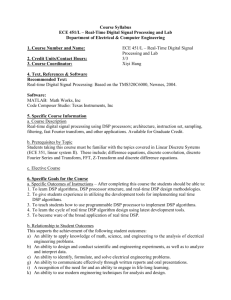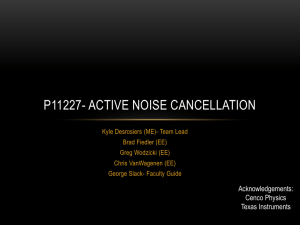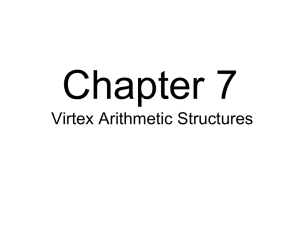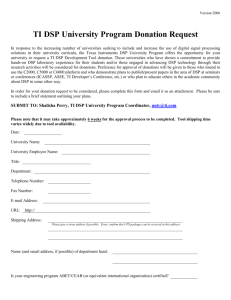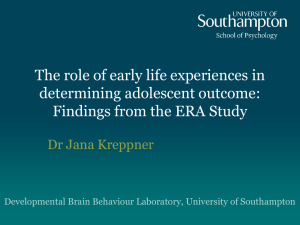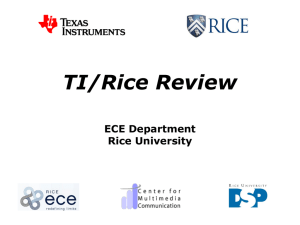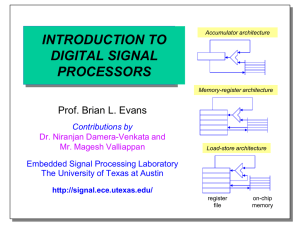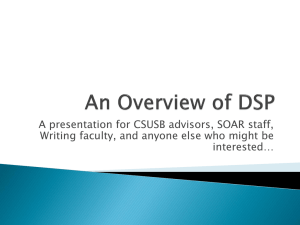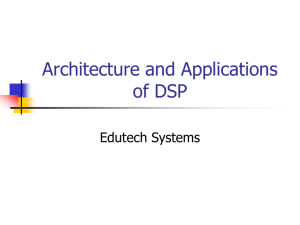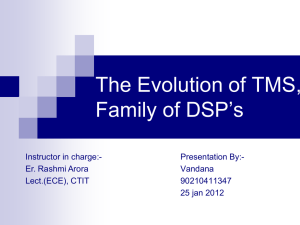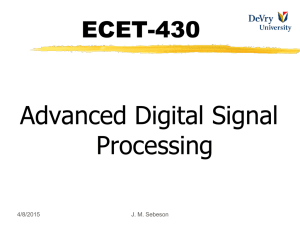here - Oxford Digital
advertisement
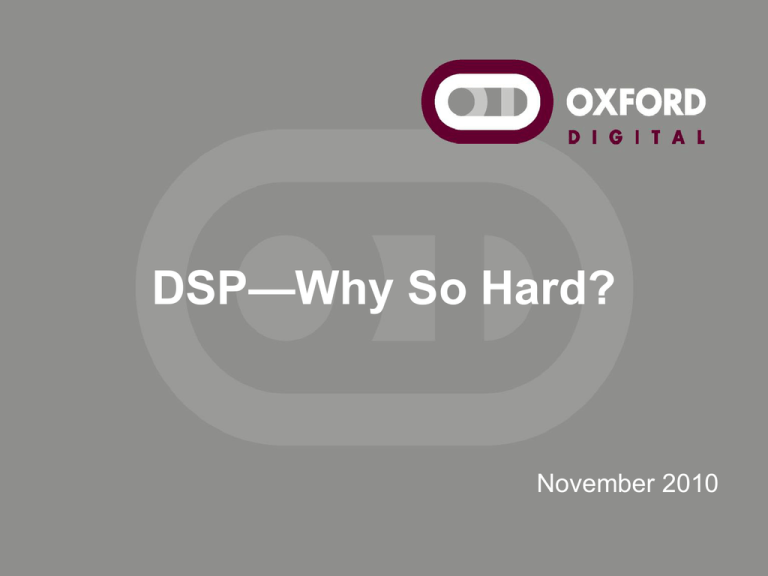
DSP—Why So Hard?
November 2010
Who ?
Peter.Eastty@Oxford-Digital.com
Design and sell processor cores and matching
programming environments.
Program strange algorithms onto stranger
processors with the strangest tools.
Customers
NDAs
Client lists.
You
Why ?
People expensive, Silicon cheap.
People slow, Silicon fast.
People slow, Computers fast.
Programmer efficiency is
everything, it gets you time to
market which gets you the
market.
Why ?
Targets move, right up to the last minute.
Never, ever build a fixed function device.
Three stories.
Third party algorithms will have to be
adopted whether public domain or highly
secret.
What is an audio signal?
Known bandwidth
Known resolution
Known number of channels
So why don’t I enumerate them
Where ?
Large mixing consoles
Cell Phones
Hi Fi
TVs
iPod docs
PCs
etc.
What processing do we want to do to
the audio?
Continuously varying value against time
Filtering
Polynomial
Non-linear
Decisions
DSP = Low Delay
Not block structured
What hardware resources are
available?
Memory
Multipliers
Connections
Adders etc.
Data types for DSP
See RBJ on headroom and floating point
Want a fixed point data type.
Word length, 16 – 32 etc. have nothing to
do with audio, setup the word-length to
suit the audio not a computer.
Languages for DSP
C is not a DSP language, the data types
are all wrong and it has no concept of
time.
C++ could be a DSP language but it
doesn’t want to be one, it too has no
concept of time.
Languages for DSP
With modern hardware design and
compiler technology there is never a need
for assembler. NEVER EVER.
Of course if you’re tied to old hardware for
legacy code reasons you still might have
to hack in assembler.
Languages for DSP
main (…)
{ ASM(…);
ASM(…);
ASM(…);
}
/* This is not C. */
Languages for DSP
main (…)
{ Clear_Acc();
MAC(…);
Store_Acc_to_Register(…);
}
/* This isn’t either.
*/
Languages for DSP
main (…)
{ Multiply_by_Coefficient();
Biquad(…);
Do_FFT(…);
}
/* Neither is this. */
Languages for DSP
Beware of ‘optional extensions’.
They can become mandatory.
There is still at least one University
teaching DSP using FORTRAN and
assembler …
...sad to say they apologized about the
FORTRAN.
Languages for DSP
I don’t know the perfect DSP language.
But any high level language is better than
any machine specific language.
Multiple Memory Banks
If there are multiple memories then
memory allocation is NOT the
programmers job, the tool-chain should do
this for you.
But it might be nice to be able to do some
if you want to.
Multiply-Add
Source level individual operations (add,
multiply etc.) should be independent,
hardware instructions can combine
multiple operations (like Multiply-Add).
Make sure the operations in a combined
instruction are exactly the same as those
in individual instructions.
Limiting
Whatever number system you use it will
have a range, even floating point.
Limiting will be required after every
operation that can exceed the range,
multiply, add, subtract and absolute value.
This includes the multiply in a multiplyadd.
-1 x -1 = -1 ????????
Pipelines
User should never have to think about
pipelines.
Variable pipelines are wrong.
Pipeline is not a panacea for timing
problems, it limits the processing in a loop.
Pushing code through a branch.
Using the pipe for parameter passing.
Pipelines
Definition of pipeline length, count
between the instruction that generates an
item and an instruction that may use it.
Short circuiting the pipe. Useful, but not
very useful.
Can unwind the execution by having
pipeline-length prime relative to instruction
count, but this adds to delay, which in turn
adds to storage requirement.
Branching
If you can find another way avoid
branches.
If you have to have jumps and a pipeline
keep it all away from the programmer.
If you do have jumps they’ll likely break
the guaranteed timing.
Conditional Execution
Conditional execution doesn’t break
pipeline etc.
But you’ll need as many condition code
stores as you have pipeline length.
Timing is identical for conditional execution
and multiplexer.
Multiplexer
y = (a < 0.0) ? b : c;
Timing is identical for conditional execution
and multiplexer.
With multiplexer you can use any variable
as a control so no condition code store is
required.
y = (a <= 0.0) ? b : c;
ABS
For simple bends in an input/output
relationship, Absolute Value plus some
Addition and Subtraction is more
economical than most other methods.
Truncation, Rounding, Dither and
Noise Shaping
For every instruction that needs it …
… and just for Output
Assume fixed point
Floating point is hard
Truncation, Rounding and Truncation
Towards Zero!.
Truncation is easy but has DC offset
Truncation Towards Zero!
½ LSB offset number systems
Rounding wins and is not much more
complex.
Dither
How do we make it?
Truly random, pseudo random, hash?
What colour do we want it to be?
What PDF do we want?
Make sure it’s un-correlated.
Want repeatability for test.
Problems with infinite gain components.
Rounding wins.
Noise shaping
What shape?
What order?
Want repeatability for test.
Problems with infinite gain components.
Rounding wins.
Make sure your instruction set can do
dither and noise shaping.
Coefficient Interpolation
Coefficients as a sampled system
SRC called interpolation
HW or SW, 2-3 instructions to feed one.
Only in exceptional circumstances is it
worth a hardware solution.
Linear is possible, first order filter is easy
and works for many applications.
Coefficient Synchronization
Coefficient synchronisation.
Lots of people ignore it or treat it on a per
use basis.
Can be done for linear or first order filters
with ease.
This is really a synchronous sampling
problem.
Coefficient
Synchronization, Synchronization
J
itter
Scaling, multiprocessors,
synchronisation & segmentation
Not all solutions fit in a single processor.
Automatic segmentation of programs
across multiple processors is possible.
But it is hard.
If the processors are not identical, and
identically connected it’s very, very hard.
Scaling, multiprocessors,
synchronisation & segmentation
If you have multiple processors and no
branches then you can run them in
lockstep, many examples.
For data transfer between processors
simply send from one processor and
receive by the other at the same time.
Disastrous for assembler, easy for
compiler.
Scaling, multiprocessors,
synchronisation & segmentation
How do you connect multiple processors,
series or parallel?
If you chose either then you can’t do some
algorithms. Use mesh or router instead.
Small routers are actually cheap and
relatively easy to generate code for.
Multiple processors I/O, dedicated
processor connections or is I/O a full
member of the clan?
Constant folding and common code
removal.
Easy in a compiler, often missed by an assembly
language programmer.
Keep everything as source until the last possible
moment.
That way common parts can be taken advantage
of, constants, but more importantly data and
instructions.
Leads to documentation of library functions
requiring “at most X data memories and Y
instructions”.
Libraries
Binary libraries don’t work well with
pipelined processors, the cost of getting
into or out of them is usually to great.
A binary library (like a dll) is NOT a secure
method of distributing intellectual property.
Encrypted source going through a trusted
tool-chain to generate encrypted binaries
is the way to go.
Hardware with problems….
Let’s just have one continuous data type
(and maybe one integer type).
Different widths for different memories
makes horrible problems.
Private instruction sets and ‘Useful’
instructions.
Hardware with problems….
Do not chisel a digital analogue of an
analogue circuit out of digits.
Sample rate to silicon clock ratio
Hardware with problems….
Bi-quad coefficient ranges.
Feedback coefficients ranges need to be
big enough.
Feed-forward coefficient ranges are not
limited, they can get big. If there’s
nowhere in your system to make gain,
you’re in trouble.
Hardware with problems….
The accumulator is dead. When hardware
was expensive and DSP engineers were
cheap it made sense to get performance
this way, but that is no longer true.
Most of today’s algorithms aren’t sums of
products anyway.
And it makes a high level description
difficult.
Hardware with problems….
Double precision is probably not the right
thing for LF filters.
Choosing the right filter structure and
adding a few bits is a financially better
solution.
Hardware with problems….
If you must have an accumulator make
sure you can load and store it!
Hardware with problems….
Shifting is required to get gain into the
system.
There are few reasons for a shift of greater
than 2^7 and very few for more than 2^15.
Shift after the multiplier, it’s the only place
where there are the bits to shift.
Shift in the wrong place is common.
Hardware with problems….
If a standard 5 coefficient bi-quad takes
more than 5 instructions there’s something
wrong.
A simple Z-1 delay, and cascades thereof
should not consume instructions.
Simple rotating memory, and language
support.
Hardware with problems….
A pipeline needs to be started cleanly.
This is not always easy.
Debuggnig
Source level debugging is perfectly
standard in almost every general purpose
processor toolset, why is it missing from
DSP toolsets?
Debuggnig
If you do add a debugger, remember that
the objects you are processing are signals,
thus they vary with time.
A numerical display of a signal is generally
useless, like using a DVM to analyse
audio, necessary but not sufficient.
Provide a scope and signal generator.
Debuggnig
Debugging Input or Output is a signal.
Easiest done by the instruction NOT the
location.
How do we make DSP easier?
Get the algorithm away from the hardware
Use DSP that is compiler compatible
DSP – Why So Hard?
Program
Only
Signals.
Easy?
Yes!
Program Only Signals. Easy? Yes!
DSP—Made Easy!
November 2010

